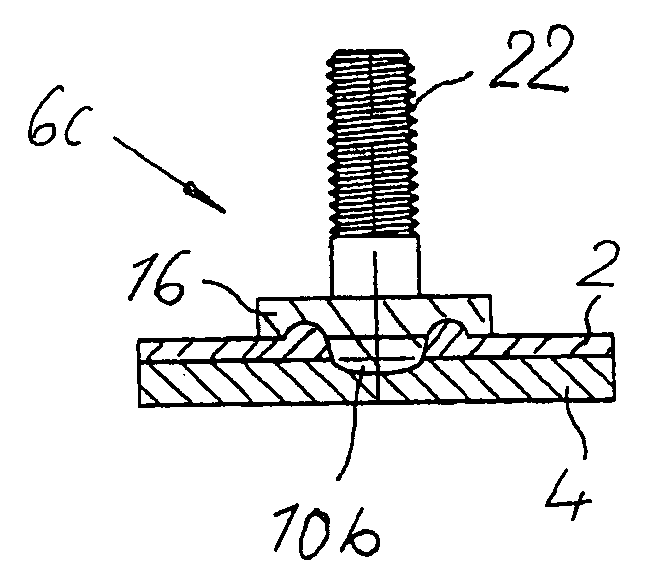Method and joining element for joining workpieces
a technology of joining element and workpiece, which is applied in the direction of threaded fasteners, soldering devices,auxillary welding devices, etc., can solve the problems of limited joint strength and many joining techniques such as self-piercing riveting and clinching, and achieve excellent joining quality and high joining strength
- Summary
- Abstract
- Description
- Claims
- Application Information
AI Technical Summary
Benefits of technology
Problems solved by technology
Method used
Image
Examples
Embodiment Construction
[0025] With reference to FIG. 1, two plate-shaped workpieces 2, 4 in abutment to each other are to be joined by a joining element 6. As an example, the workpiece 2 is a frame member of steel (lower workpiece 4) which is to be “covered” by an aluminium sheet (upper workpiece 2).
[0026] The joining element 6 is, in the embodiment of FIG. 1, a rotationally symmetrical member comprising a conical body portion 8 and a conical penetrating portion 10 terminating in a tip. The body portion 8 is provided with a drive means 12 comprising a recess (e.g. a polygonal depression, a slot, a torx) as indicated by dotted lines.
[0027] For making the joint the joining element 6 is driven by drive means (not shown) so as to perform simultaneous rotational and translational movements as indicated by the arrows Fa and ω, whereby the tip of the conical penetrating portion 10 of the joining element 6 penetrates from above into the material of the workpieces 2, 4.
[0028] As shown in FIG. 2 the joining elem...
PUM
| Property | Measurement | Unit |
|---|---|---|
| Angle | aaaaa | aaaaa |
| Angle | aaaaa | aaaaa |
| Angle | aaaaa | aaaaa |
Abstract
Description
Claims
Application Information
 Login to View More
Login to View More - R&D
- Intellectual Property
- Life Sciences
- Materials
- Tech Scout
- Unparalleled Data Quality
- Higher Quality Content
- 60% Fewer Hallucinations
Browse by: Latest US Patents, China's latest patents, Technical Efficacy Thesaurus, Application Domain, Technology Topic, Popular Technical Reports.
© 2025 PatSnap. All rights reserved.Legal|Privacy policy|Modern Slavery Act Transparency Statement|Sitemap|About US| Contact US: help@patsnap.com



